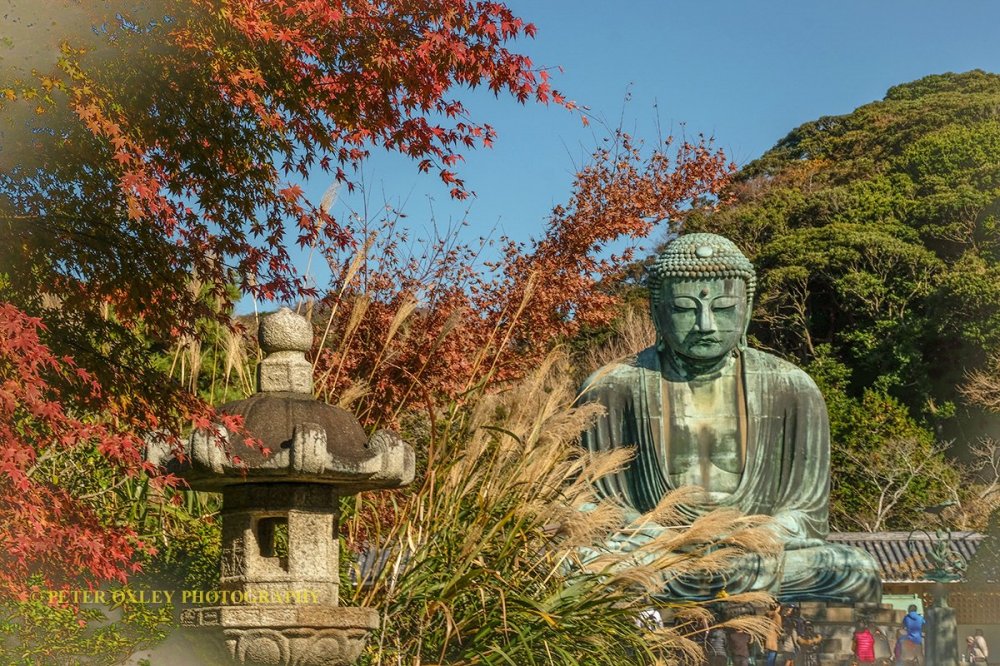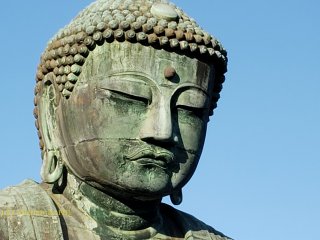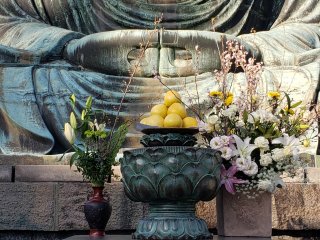A Gigantic Seated Divinity of Bronze
I shall begin with a quote from the celebrated American author and traveler, Bayard Taylor, who visited Japan in the middle of the 19th century as part of the Perry Expedition. These were his thoughts on visiting Kamakura. They succinctly exemplify the observations that might very well pass through the mind of a traveler visiting the monument today in the 21st century.
The Great Buddha may be considered as the most complete work of the Japanese genius in regard to both Art and to religious sentiment …. A gigantic seated divinity of bronze, with folded hands, and head gently inclined in an attitude of contemplative ecstasy…. There is an irresistible charm in the posture of Daibutsu, in the harmony of his bodily proportions, in the noble simplicity of his drapery, and in the calmness and serenity of his countenance.
Designated a National Treasure, the Kamakura Daibutsu, or Great Buddha, of Kamakura, is a representation of Buddha Amitabha, the Lord of the Western Pure Land. Kotoku-in, the temple where it stands, belongs to the Jodo-shu sect, a very popular branch of Buddhism amongst the Japanese.
The Shogun's Dream and Subsequent Construction
History has it that in 1185 Minamoto no Yoritomo, the first shogun of the Kamakura Period (1185-1333) visited the Nara Daibutsu at Todaiji in Nara to attend the inauguration ceremony of the reconstruction of the greatly revered statue after its destruction in 1180 by the rival Taira or Heike clan.
The colossal statue, the biggest in Japan, inspired the young shogun, who had just emerged as the new unchallenged ruler of Japan, to construct an equally monumental counterpart in the east, home base of his victorious Minamoto clan. This, however, was not to be achieved in his lifetime but many years after his death when the project was revived by some of his followers, particularly the lady Inada no Tsubone, and supported by his in-laws, the Hojo family, then regents to the shogunate.
The original concept had been to construct a wooden image but this was replaced with a gilded one - in bronze - whose construction was begun in 1252. The icon was housed inside a huge wooden structure, but tropical storms, earthquakes, and tsunami repeatedly destroyed the hall over the years, and in 1498, after one particularly massive wave devastated the area in the wake of the Nankai Earthquake, the statue was left standing alone. One has to remember that by this time in history, the center of power had moved back to Kyoto, and funds were no longer available for repair and reconstruction. Thus, the Great Buddha stayed out in the open, where it remains to the present day.
The statue is a composite of pieces of bronze forged together. If you look closely, you can see the joints and sutures. A closer look in the temple precincts reveals foundation stones that show just how big the original hall of Kotoku-in Temple was.
Features That Draw Heavily on Gandhara Style
Let’s take a look at the Buddha in the photographs shown here. You will see that he is in a seated position leaning forward. This style is typical of Buddhist sculptures in Song Dynasty China. Here are some of its features:
The eyebrows are semi-circular; the eyes horizontal. The ridge of the nose starts from the forehead. He has a fine and long moustache. The mouth expresses an Ionic smile, influenced by Gandhara sculpture. The hair is made up of 656 curls, winding clockwise. A white curl on the forehead created from six kilograms of silver symbolizes a third eye, which represents the ability to see the true nature of things, while a protuberance on top of the head signifies wisdom. The ears are large and long (a good listener) and the webs between the fingers signify fulfillment. This is the typical meditation pose.
The legs are crossed in a lotus position, the body inclined forward, and the direction of the eyes set at right angles, giving the impression that he is looking directly at where you are standing. The upper part of the body is larger in proportion to the lower part so that the perspective when viewed from the ground appears normal. The overall pose of the statue gives the visitor a feeling of intimacy.
There are many elements in the overall design, such as the drapery of the robe, that draw heavily from Gandhara sculpture, which is based on Greco-Roman style. Gandhara art flourished around the 1st-5th century AD, predating the spread of Buddhism from India through China, Korea, and on to Japan.
The Great Buddha is hollow inside. It weighs 121 tons and stands on its plinth 11.3 meters tall. You can take a look inside if you wish. The Nio-mon Gate at the entrance to the temple is flanked by two fierce-looking guardian deities (nio), one with his mouth open and the other with his mouth closed. They appear to be uttering “ah” and “un”, the first and the last breath of life, similar to alpha and omega.
Always a Pleasure to Visit, Whatever the Season
It is always pleasure to visit Kotoku-in and the Great Buddha, whatever the season. Camellias bloom in February, cherry blossoms in April, and the glorious colors of autumn are resplendent in November and December.
Families love it here and children look up at the statue in awe and wonderment. A very nice touch is a display of 1.8-meter-long straw sandals first woven by schoolchildren at a certain high school in the 1950s and replaced every three years. Apparently, the kids came up with the idea that the Great Buddha might sometimes need the footwear to stride the length and breadth of Japan.
There is something uplifting about a visit to this temple, from the moment you walk through the gate when you see the head of the Buddha over the perimeter fence to when you leave the tranquil grounds with a heart full of joy.
The fact is that here is a figure, homeless, out in the open, dressed in simple garb, and yet radiating such peace and serenity. Food for thought, one might say, in our troubled world. Indeed, indeed!
For those with a more exploratory and energetic nature, there’s a hiking trail just behind the temple grounds that will take you up to Genjiyama Park and onward to Kita-Kamakura. Enjoy!
Getting there
A 30-minute walk from Kamakura Station. Or take a bus from the East Exit of the station. Or three stops on the privately run Enoden Electric Railway to Hase followed by an 8-minute walk.
More info
Find out more about Kamakura Buddha (Kamakura Daibutsu).















































